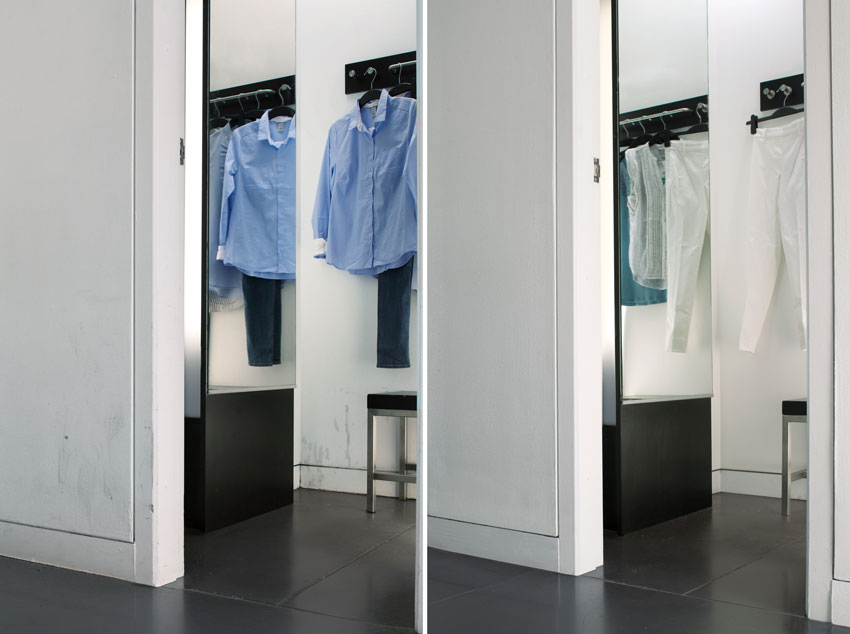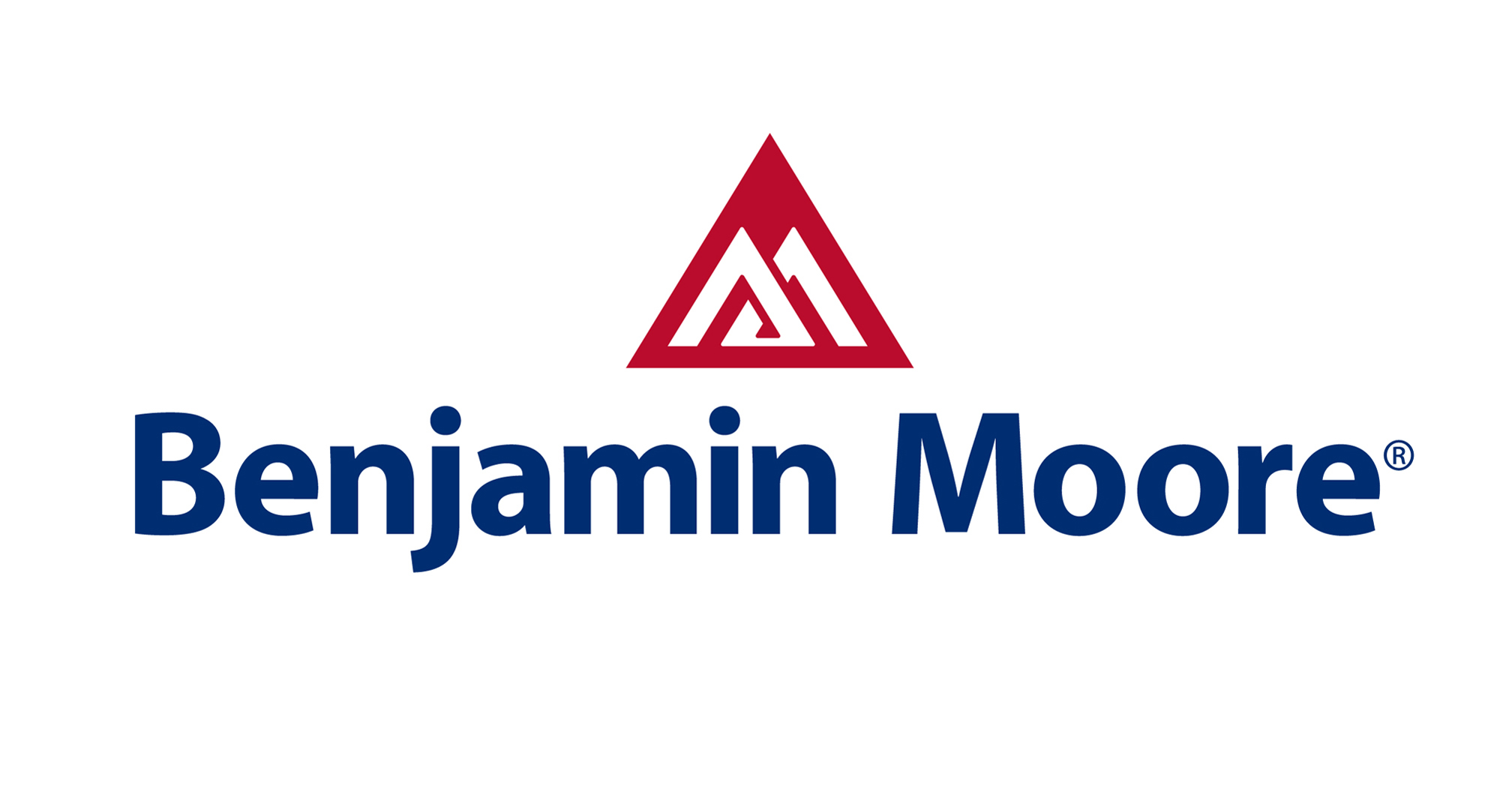Evaluating Cost
Competitive first-cost pricing of a paint system is important for every project, but in many high-traffic commercial interiors, additional factors complicate the calculation. Cost must be balanced carefully with the specific performance needs in the space. For example, clients making decisions for institutional, corporate, and commercial facilities are often the owners and operators as well, with a direct business interest in on-going maintenance and life-cycle cost.
Life-cycle cost calculations vary widely. The calculation of the cost should provide a comparison of options, taking into account the cost of the paint and any other supplies, and the labor for the application. In high-traffic environments, it is of particular importance to consider the cost of maintenance, service disruption, and lost time for the business or other mission of the space.
Important factors in this calculation include the paint’s coverage, ease of application, level of required maintenance, durability, and service life. The paint’s application properties, for example, will determine how much paint is needed, and how much labor, time and equipment will be required. The maintenance and replacement requirements will determine the cost of labor, time, materials, and equipment, plus considerations like disruption and impact on the activities in the space. If building occupancy or use needs to be restricted during painting, for example, or if the labor required must be specially trained and supervised, these all add to the first cost and will affect every retouch and repaint too. Lower-cost paints may save money initially, but the finish will not hold up to the wear and tear typical of high-traffic environments, resulting in scuffed and marred surfaces; consequently, the cost of repainting may quickly surpass the initial savings.
Since labor is invariably the highest cost in any painting project, if a paint can reduce the personnel hours required on a regular basis for maintenance and the skilled labor required for retouching, repairs, and ultimate repainting, then there will be lower labor costs over the life cycle of the surface.
Summary: All-Around Performance
The unique one-component, waterborne, scuff-resistant latex paint described in this course retains the clean appearance of new paint through a longer service life in highly demanding environments, reducing the need for cleaning, repair, retouching, and repainting. While the formula significantly extends the life of the coating in these applications, it does not require the time-consuming, complicated measuring, mixing, and curing of two-component systems often selected for hardness and durability in high-traffic areas. Scuff-resistant paint delivers significantly lower maintenance cost combined with the aesthetic value that is essential in brand-conscious commercial, corporate, and institutional spaces, such as retail stores, hotels and restaurants, schools and universities, corporate offices, hospitals, and other health-care settings.
Key Features of Scuff-Resistant Paint
- Patent-pending breakthrough scuff-resistant technology
- Patent-pending CHIP-TECH® chip resistant technology in semi-gloss only
- Single-component latex formula
- Highly resistant to scuffs and marks
- Long-term durability with minimal maintenance
- Reduces life-cycle cost of maintenance, retouching, repairing, and repainting
- Easy to clean with soap and water or household cleaners
- No mixing, measuring, or limited pot life
- Easy application
- Quick drying for fast turnaround and minimal disruption
- Same-day return to service: apply paint during business hours with little service disruption, eliminate overnight painting costs
- LEED v4 eligible and Collaboration for High-Performance Schools (CHPS) certified
- Available in matte, eggshell, satin, and semi-gloss
- Available in thousands of colors, tinted with Gennex® colorants
- Non-flammable, Class A (0–25) over noncombustible surfaces when tested in accordance with ASTM E-84
- Contains antimicrobial additives that inhibit the growth of mold and mildew on the surface of the paint film
Layne Evans is a writer specializing in architecture, construction, the building industry, energy, and the environment. She has created more than 50 print and multimedia continuing education courses.
 |
Founded in 1883, Benjamin Moore is North America’s favorite paint, color, and coatings brand. A leading manufacturer of premium-quality residential and commercial coatings, Benjamin Moore maintains a relentless commitment to innovation and sustainable manufacturing practices. The portfolio spans the brand’s flagship paint lines, including Aura®, Regal® Select, Natura®, and ben®. Benjamin Moore is renowned for its expansive color portfolio, offering consumers and designers more than 3,500 colors. Benjamin Moore paints are available exclusively from its more than 5,000 locally owned and operated paint and decorating retailers.
Explore the Benjamin Moore testing facility and Ultra Spec Scuff-X by watching this video.
www.benjaminmoore.com
|
The painted surfaces in high-traffic environments come into constant contact with people, furniture, equipment, and a range of other challenges depending on the space. As a result, intensive cleaning has always been accepted as a routine part of maintenance. Frequent retouching, repair, and eventual repainting are inevitable. Even with careful maintenance, many painted surfaces in high-traffic settings can appear worn after only a few months in service.
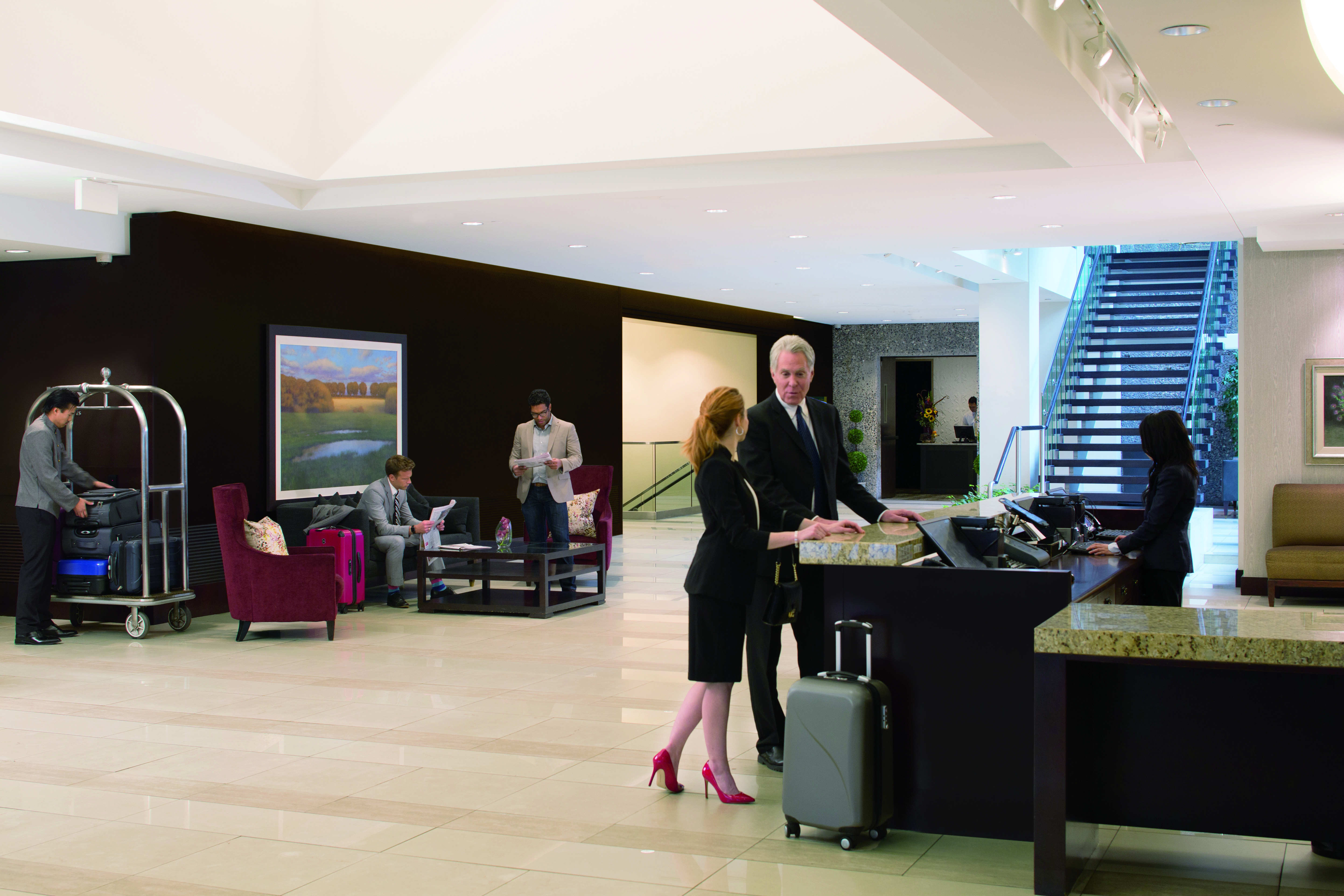
All images courtesy of Benjamin Moore
Scuff-resistant paint repels marks and keeps surfaces looking newly painted in high-traffic areas for extended periods, without the need for frequent cleaning and retouching.
Three major solutions are:
- heavy-duty, two-component epoxies that require measuring, mixing and have a short pot-life;
- pre-catalyzed, one-component epoxies formulated primarily to withstand the frequent hard scrubbing needed to remove daily marks and stains; and
- conventional latex paints in a higher sheen to increase cleansability.
In this course we will examine one-component scuff-resistant latex paint, an effective solution for demanding, high-traffic environments, and will explain how it works, how it differs from other coatings used in high-traffic environments, and how it helps improve all-around performance.
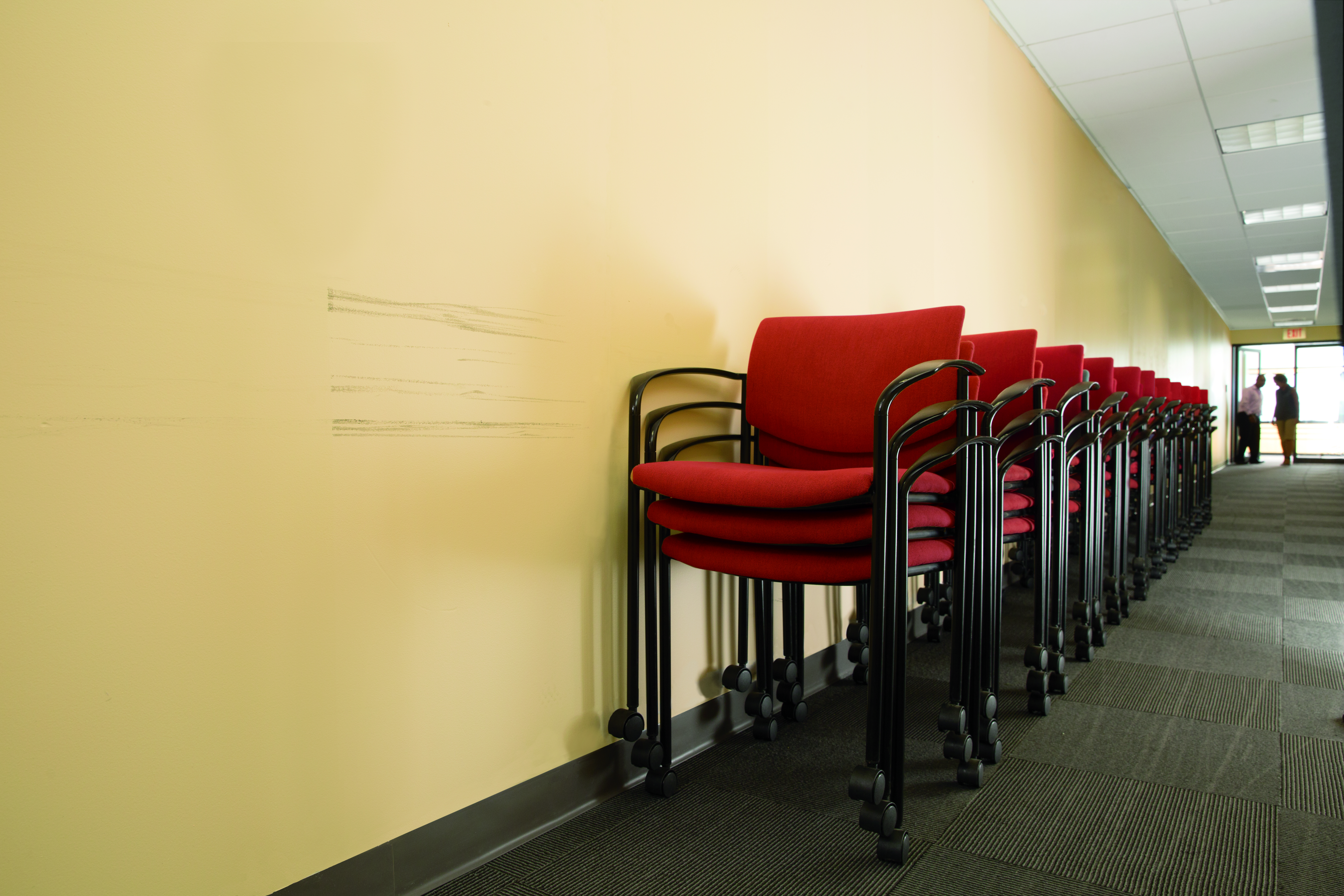
“Scuffs” cover many kinds of disfiguring marks left by the constant flow of people and equipment in high-traffic hallways in corporate facilities.
Demand for Durability
Although in many interiors the most challenging decisions are related to color and design, in high-traffic areas there are additional physical demands. Every day in high-traffic commercial environments there are multiple opportunities for the walls to be rubbed, marked, stained, and scuffed, by impact or simple contact.
The breakthrough formula in this scuff-resistant paint was developed to address challenges faced in these demanding environments. “These are 24/7, high-occupancy, high-abuse environments. Painting is a definite interruption. We were hearing frustration from many companies about serviceability, the real business cost of constant cleaning and repainting, even using heavy-duty epoxies,” says Jim Gorman, senior strategic account manager, national accounts for Benjamin Moore & Co., who works directly with large corporations such as national hotels, restaurants, and retail chains with hundreds of facilities. “We went to our research department with a list of really specific requirements.”
The basic requirements included that the paint: be one-component to avoid the complications and risk of error when mixing two-component paints; have low VOCs; be fast drying and have less odor to permit painting while operations continued with minimal disruption and quick return to service; and have something that wasn’t available in existing paints: the ability to resist scuffs and marks for minimum maintenance and repainting. The paint had to perform in a wide range of high-traffic applications, each with unique challenges:
- Health care: The overall sector includes many different types of settings, from hospitals to outpatient centers to specialty care facilities, as well as a growing number of specialized spaces for an aging population, ranging from varying levels of assisted living to modifications for aging in place. (See “Design for an Aging Population” case study.) Heavy traffic includes not only patients, families, visitors, and staff but also intensive use of equipment: rolling carts, beds, and high-tech treatment and monitoring units. The need for extreme cleanliness is fundamental. Disruption must be severely minimized and areas rapidly returned to service. Paints may need to include antimicrobial additives to inhibit the growth of mold and mildew on the surface of the paint film.
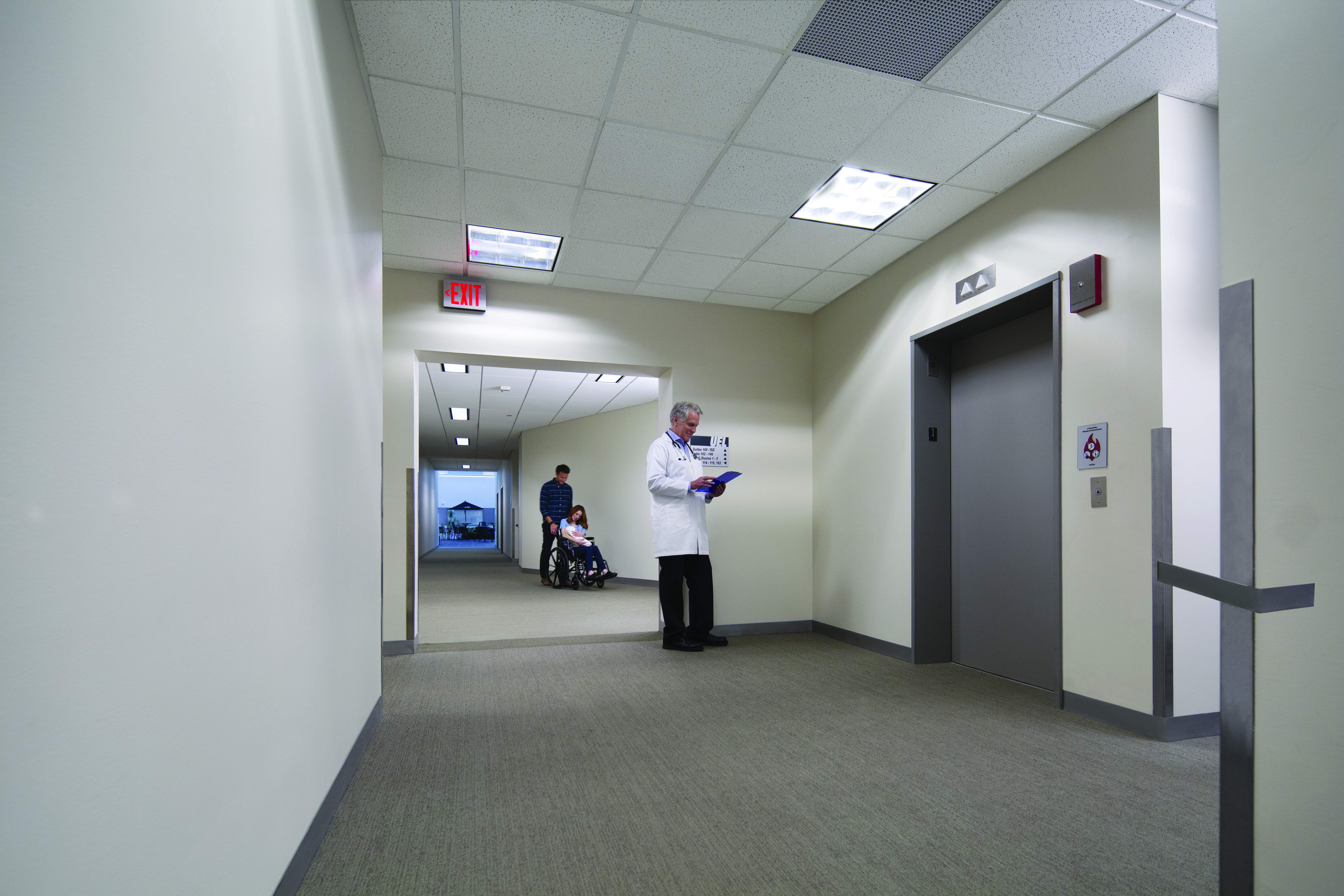
Durable surfaces that maintain cleanliness, a welcoming atmosphere, and a safe, healthy environment are critical in health-care settings.
- Education Daily heavy traffic characterizes all types of educational settings, in classrooms, hallways, cafeterias, dormitories, stairwells, gathering spaces, and gyms. Visual design must be appealing and support learning. Many new signature buildings on university campuses in particular feature state-of-the art architecture and performance. But educational buildings of all types generally have strict operation, maintenance, and replacement budgets and select products for long-term durability. For example, at the Independent Day School in Middlefield, CT, scuff-resistant paint was used throughout common areas, hallways and restrooms. According to Jim Rumberger, Director of Facilities, “Clean-up is easy, just a wet wipe. But my favorite aspect of the paint was the fact that I will not have to go back and paint hallways and rooms every year.”
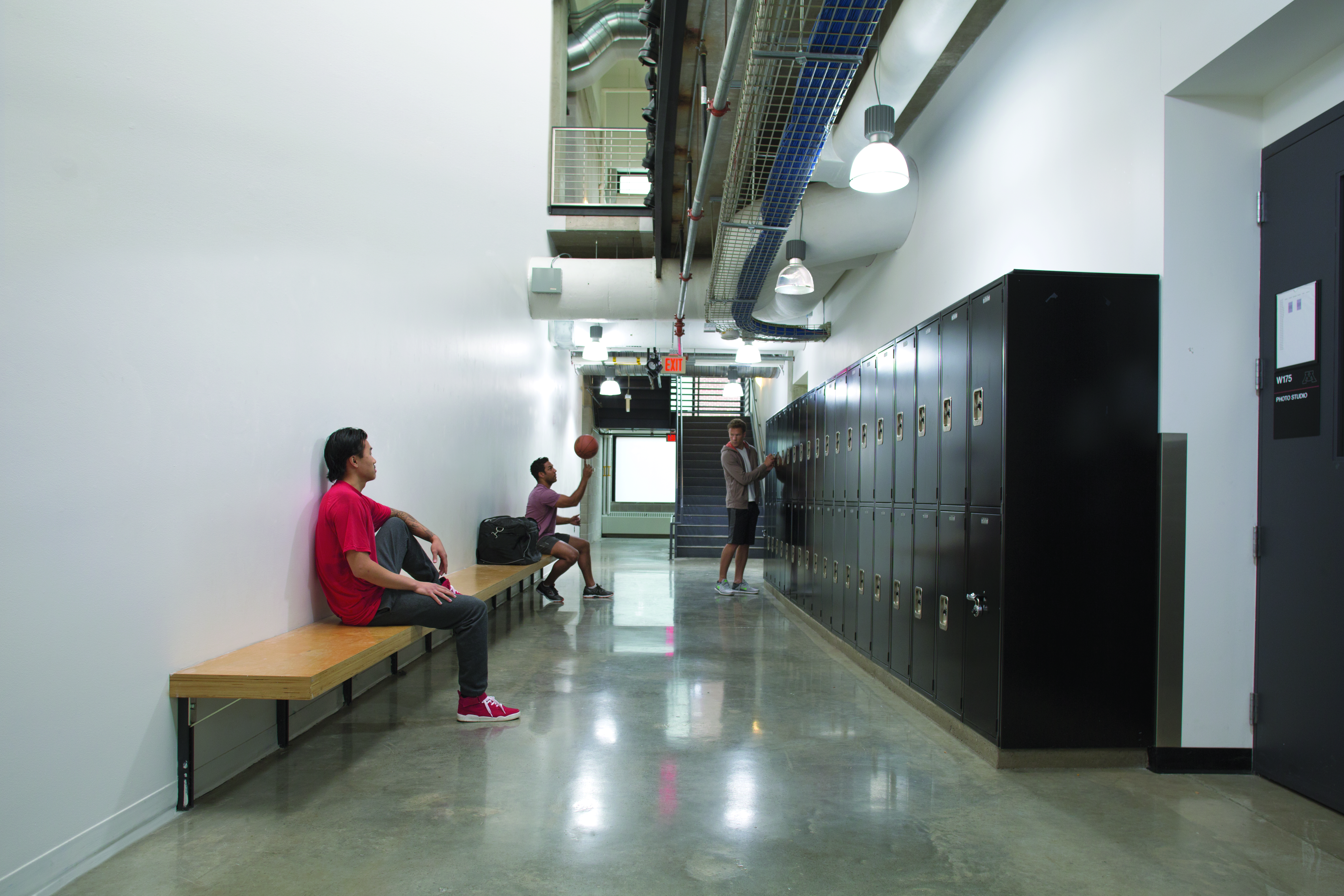
Painted surfaces in all types of educational settings are subject to daily heavy traffic. Scuff-resistant paint maintains clean appearance without frequent scrubbing and retouching.
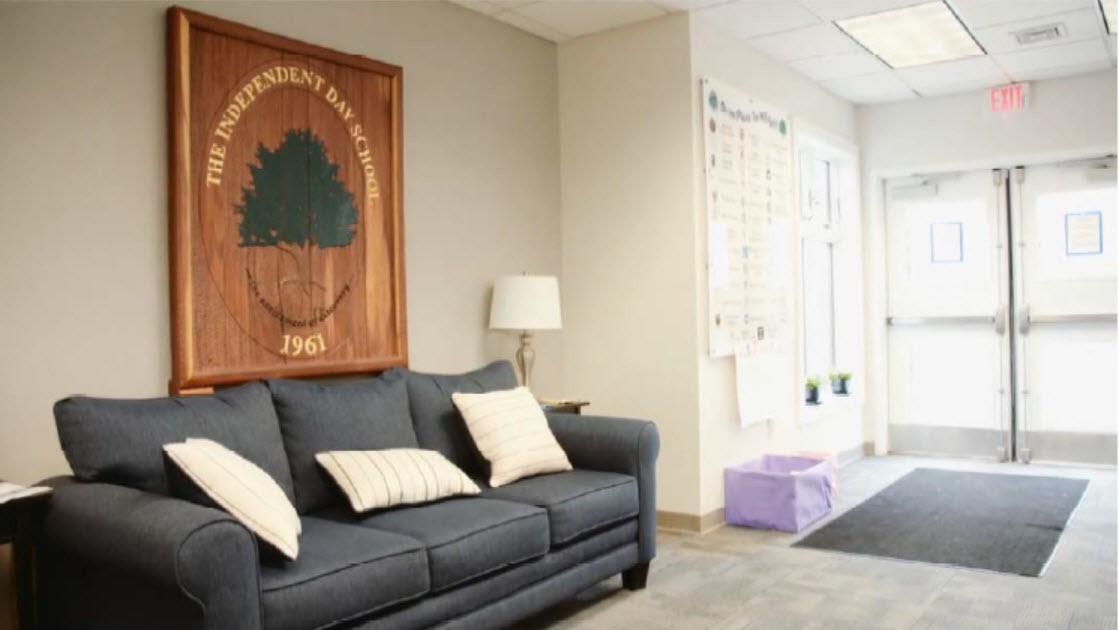
In educational facilities like the Independent Day School, low maintenance requirements for cleaning and retouching and long-term durability are key benefits of scuff-resistant paint formulas.
- Corporate, business, and public buildings: In these types of spaces, from corporate headquarters to restaurants to airport terminals, visual design appeal is a priority. Many large corporations are highly brand conscious, and colors are an essential part of that brand, including when the color scheme is based on bright white. But constant heavy traffic of people and equipment results in severe wear to painted surfaces. Minimizing maintenance and downtime is important. For example, vacant spaces in office buildings must be quickly repainted for new occupants or painted while furnished.
- Hospitality: In these settings, there is a constant flow of guests, service personnel, cleaning, and maintenance crews throughout the facility in guest rooms, lobbies, stairwells, restaurants, and service areas. Furniture and equipment are frequently moving in public spaces and dining areas. In many large hotels, for example, the largest source of unsightly damage to walls is the housekeeping staff, working quickly with large carts and other cleaning equipment. In restaurants, a small space such as the storage area for high chairs, always visible to the public, might be almost impossible to keep presentable and free from marks without frequent retouching. Most areas cannot be closed for more than a short period for painting and maintenance.
- Retail: For stores and retail businesses of all kinds, a welcoming, attractive atmosphere that reinforces the brand of the business is key, but constant heavy traffic and hard wear and tear in fitting rooms, elevators, and employee spaces require exceptional durability. Fitting rooms are a good example of the problems involved. Retailers often refer to these as “revenue rooms,” the points at which most purchasing decisions are made. Yet constant banging from hangers and pocketbooks, marks from shoes and lipstick, and other normal contact with shoppers makes fitting room surfaces difficult to keep attractive. For retailers, every minute the doors are closed for maintenance means lost revenue so the ability to paint and repaint rapidly during business hours for minimal disruption is important. Profit margins for retail business are typically tight, so cost-effective maintenance and reduced labor requirements for frequent touch-ups can make a significant difference. (See “New York City Retail” case study.)
In general, durability priorities vary along a broad spectrum, from residential to commercial to industrial environments.
In heavy industrial facilities or in settings where painted surfaces are subjected to chemicals, heavy abrasion, or consistently high levels of moisture, the increased cost of specialized two-component coatings may be warranted. They require precise measurement, mixing, and curing under highly controlled conditions, not only for the original painting, but also for every time a retouch of any scale is done. (See Comparing Coatings section.)
In the broad range between low-traffic areas and heavy industrial facilities, there is a large segment of high-traffic commercial environments where heavy-duty industrial coatings are not necessary or desirable, but constant wear and tear requires increased durability. For these settings, scuff-resistant paint can be an effective option.
Scuff Resistance vs. Scrub Resistance
As noted above, constant wear and tear in high-traffic environments leaves daily marks. This creates an inherent dilemma. The surfaces must frequently be cleaned and scrubbed, often with conventional cleaners, to try to remove severe stains and scuffs.
But the cleaning itself causes damage. Cleaning and scrubbing are mechanical processes that remove not only the marks but, in most latex paints, also molecules of paint, eventually wearing away the paint film. Many conventional latex paints used in high-traffic areas may be subject to “burnishing,” a disfiguring increase in sheen creating an uneven appearance (see image below) in paint that has repeatedly been rubbed, particularly by frequent washing and spot cleaning. Burnishing occurs most often in flatter finishes and deep colors, but some paints may burnish in both light and dark colors. Sooner or later, burnishing will require retouching and then repainting. Depending on the characteristics of the space and the paint, “sooner” can be within months.
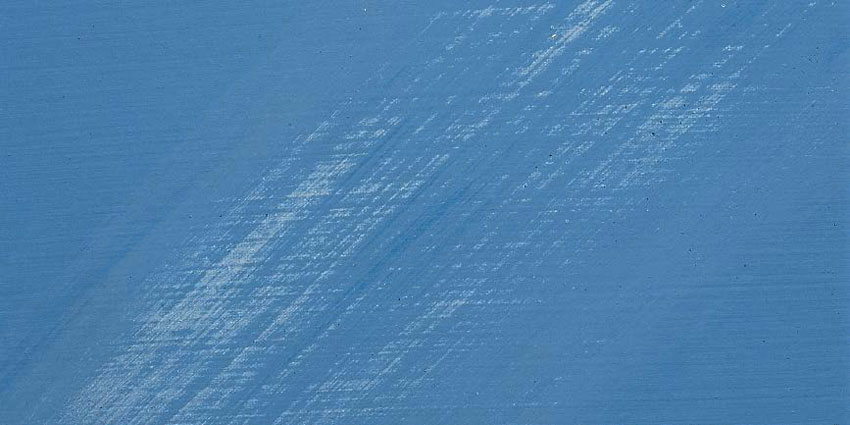
Paint that is repeatedly rubbed, particularly during cleaning and scrubbing, develops a disfiguring, uneven appearance called “burnishing.”
As a result, one of the primary characteristics of paint selected for high-traffic environments has been its scrub resistance, reflecting the reality of the need for frequent cleaning. The assumption is that the marks will have to be scrubbed off the surface. Removing the marks involves some level of mechanical erosion of the paint film.
Scrub resistance is a paint’s ability to withstand the scrubbing necessary to remove stains or marks with no changes to the coating’s appearance or its protective functions. Scrub resistance is measured in scrub cycles and scrub ratings, determined by a test method in ASTM D2486. Dried paint samples are repeatedly scrubbed with an abrasive brush until the surface of the paint deteriorates. A high scrub rating indicates that the paint will hold up to frequent abrasive cleaning longer than a paint with a lower rating before it is physically damaged.
This is an attribute of paints in high-traffic environments. However, coatings such as two-component and pre-catalyzed epoxies with higher scrub cycles do not reliably resist scuffs and marks.
In contrast, the technology in scuff-resistant waterborne latex paint takes an entirely different approach. It creates a surface that resists the scuffs and marks. Contact from people and objects that would leave marks on conventional commercial and industrial paints does not adhere to scuff-resistant paint. If scuffs appear at all, they wipe away easily with soap and water—without scrubbing. Less cleaning, retouching, and repainting is required, which lowers the total maintenance cost.
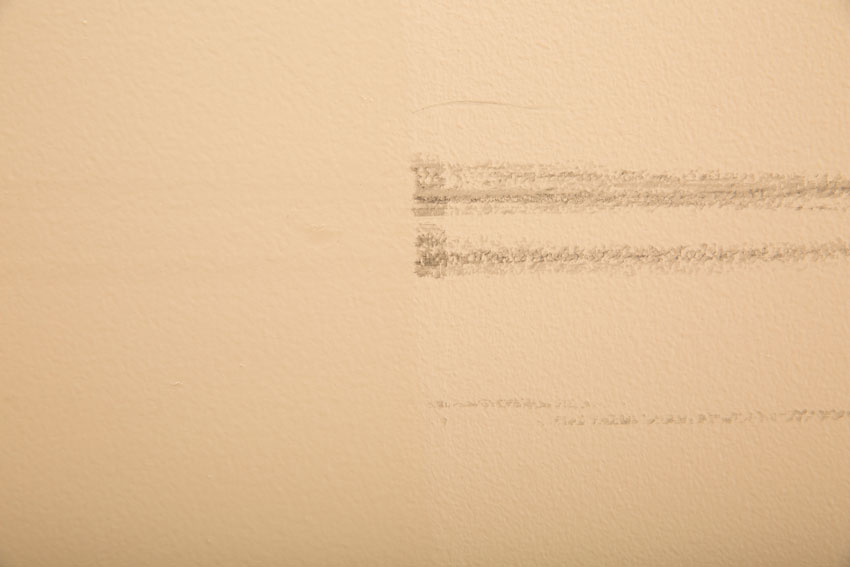
The left side of the sample board was painted with scuff-resistant latex paint and the right side with a two-component scrub-resistant paint. Both sides suffered repeated scuffing, but the left side of the sample board with scuff-resistant paint does not show it.
In addition to the reduction in the cost of maintenance, the scuff-resistant paint solves another challenge in high-traffic environments. By definition, these places are constantly used by many people, so closing them for extended periods is difficult for the businesses and activities that are operating there, and in some cases, such as hospitals, nearly impossible. Scuff-resistant paint dries to the touch in an hour and can be recoated in 2–3 hours and rapidly returned to service. Downtime and disruption are minimized.
Comparing Coatings Used in High-Traffic Environments
Architectural coatings have evolved rapidly in recent years. Only a few years ago, extended durability in demanding applications was only available in formulas that were complicated to mix and apply and contained high levels of VOCs. Intense research and pressure for more environmentally responsible, more versatile paints led to improved formulas.
Paints can be compared in a number of ways—by their resin, curing mechanism, function, thinner type, use, or finish. Coatings for high-traffic and other demanding applications have been developed to solve a range of problems. The primary division is between solvent-based and waterborne applications, although many hybrid types also exist.
This course focuses on waterborne formulas specifically developed for high-traffic environments. Latex coating systems have inherent advantages, including good gloss retention and superior resistance to fading, yellowing, and rub-off. They can also be engineered for superior stain blocking, durability, and flexibility.
Current paint options recommended for high-traffic areas where durability is a key factor include: conventional latex coatings (often used in higher sheens like eggshell and semi-gloss), two-component systems, pre-catalyzed, and scuff-resistant paint. Each of these has specific characteristics that can meet a project’s specific needs. Often, these needs can vary even among different areas within the same project.
Latex Coatings in Higher Sheens
Widely available conventional latex paints are recommended in high-traffic environments in higher sheens in an effort to improve cleansability. Although a higher sheen like a semi-gloss will slightly enhance an ordinary paint’s washability and reduce burnishing, it does not solve the most important problems in high-traffic environments. A higher sheen does not effectively resist scuffs in high-traffic environments resulting in increased maintenance and cost.
Sheen is a measure of how much light is reflected from the surface, so the same property that enhances durability can also accentuate surface flaws, making even a small indentation or imperfection of the wall more noticeable. Higher-sheen paint is also difficult to touch up because the differences between the retouched and original paint are visible.
The gloss level of a coating is influenced by the surface roughness on a molecular level. In flatter paints, protrusion of many pigment particles through the resin layer causes diffraction of light and creates dullness. The protrusion of the pigments (the color) also means it is easier for cleaning to wipe them away, the basic reason why flatter paints discolor or burnish more easily.
In high-gloss surfaces, the pigment is completely coated with the resin and does not protrude. The surface is smoother, and the angular light reflected produces a glossy appearance, not unlike a polished glass surface. The relative ease of washing these surfaces without removing pigments means that the choice for finishes in high-traffic environments has been highly weighted toward higher sheens, resulting in shinier walls. One of the benefits of the new scuff-resistant paint formulation is that it not only resists scuffs and marks, but it also is available in flatter finishes so it can be used in a wider range of designs.

Sheen variation: Note how the pigment particles are completely below the latex surface in the gloss paint but exposed to the surface in the flat finish. The pigment in the flat finish scatters light which reduces gloss, but this also makes the paint more vulnerable to abrasion, moisture, and dirt.
Two-Component System
A two-component system consists of two parts. The “A” component is the base resin, and the “B” component is the catalyst or hardener. When the two components are combined, a chemical reaction occurs, crosslinking the resin molecules and resulting in a coating that will form an extremely hard and durable finish. Two-component systems are designed to provide a highly scrubbable surface that resists common cleaning chemicals.
Two-component systems, once fully cured, create an extremely hard surface, and water-based formulas are an improvement over solvent-based epoxies from an environmental perspective. Two-component coatings are often used in applications that require resistance to harsh chemicals, abrasion, and corrosion. Still, two-component coatings require precise measurement and mixing, and curing in consistent temperatures well above room temperature, sometimes requiring heat rooms or heat blankets. At times, special preparation of the substrate may be required. The two-component coating’s properties come from a chemical reaction, and the reaction requires time and specific conditions.
Once mixed, the pot-life of the coating is limited, ranging from minutes to hours depending on the formula, the exact ingredients, the speed of the hardener, the temperature, and other factors. Pot life is the amount of time after mixing a two-part paint system during which the resin can be applied.
If conditions for mixing, curing, and applying two-part coatings are not exactly right or the pot life is exceeded, the performance of the surface will be degraded or fail altogether. This can be a significant business risk in busy high-traffic spaces. For example, if a waiting room in a healthcare setting is closed for painting at midnight, which is often the only time painting can be done, and the two-part coating is mixed incorrectly, then the walls will not be dry the next day, and the waiting room will have to be closed for more drying or, in many cases, for another repainting.
The measuring, mixing, curing, and precise timing needed for two-part coatings are not just for the initial application. The same complicated process will be necessary every time a retouch or repair of any scale is done over the entire life cycle of the painted surface. The labor and disruption of service can add significant cost to the total life of the project.
The cost, labor, and complications may be more readily justified in areas such as chemical plants or industrial facilities than for the vast majority of commercial applications, even those with the highest traffic and daily wear and tear. The formulas for two-component coatings are maximized for scrub ratings, meaning relative resistance to frequent intense cleaning. They are not formulated to resist marks and scuffs.
One-Component Pre-Catalyzed Epoxies
Pre-catalyzing epoxies at the factory was a significant innovation, creating epoxies with performance comparable to two-component systems but without the measuring, mixing, and curing. One-component pre-catalyzed epoxies cure to a hard, durable, scrubbable finish. They are also resistant to conventional cleaners. However, like the two-component systems, most pre-catalyzed epoxies do not resist scuffing. Instead, they are engineered to hold up to frequent cleaning for a longer period before showing visible wear to the finish. But without scuff resistance, the heavy scuffing and marking in high-traffic environments will require repeated scrubbing on a regular basis, and eventually, the paint finish will be damaged.
Scuff-Resistant Latex Paint
This innovative, patent pending single-component scuff-resistant paint is designed to deliver the benefits of a two-component coatings, but with the added ability of resisting scuffs and marks. It is significantly easier to use and apply and requires minimal maintenance, ultimately saving time and money. For all high-traffic walls and trim, the scuff-resistant formula provides long-term durability without the measuring, mixing, short pot-life, and application difficulties associated with other products often specified in high-traffic environments.
In addition, unlike many of the industrial coatings, the scuff-resistant latex paint delivers the application properties and environmental performance of the highest-quality architectural paints (see All-Around Performance section). It is available in a complete range of colors and finishes and retains its scuff-resistant properties in matte, eggshell, satin, and semi-gloss.
In addition to resisting scuffs the semi-gloss finish is chip resistant to protect trim, door jambs, base boards, and other surfaces against direct impact and chipping. It is engineered with patent-pending scuff-resistance and chip-resistant technology CHIP-TECH ® to deliver a unique blend of toughness and flexibility to withstand direct and glancing blows on challenging surfaces, including trim, door jambs, elevators, windows and columns.
Evaluating Cost
Competitive first-cost pricing of a paint system is important for every project, but in many high-traffic commercial interiors, additional factors complicate the calculation. Cost must be balanced carefully with the specific performance needs in the space. For example, clients making decisions for institutional, corporate, and commercial facilities are often the owners and operators as well, with a direct business interest in on-going maintenance and life-cycle cost.
Life-cycle cost calculations vary widely. The calculation of the cost should provide a comparison of options, taking into account the cost of the paint and any other supplies, and the labor for the application. In high-traffic environments, it is of particular importance to consider the cost of maintenance, service disruption, and lost time for the business or other mission of the space.
Important factors in this calculation include the paint’s coverage, ease of application, level of required maintenance, durability, and service life. The paint’s application properties, for example, will determine how much paint is needed, and how much labor, time and equipment will be required. The maintenance and replacement requirements will determine the cost of labor, time, materials, and equipment, plus considerations like disruption and impact on the activities in the space. If building occupancy or use needs to be restricted during painting, for example, or if the labor required must be specially trained and supervised, these all add to the first cost and will affect every retouch and repaint too. Lower-cost paints may save money initially, but the finish will not hold up to the wear and tear typical of high-traffic environments, resulting in scuffed and marred surfaces; consequently, the cost of repainting may quickly surpass the initial savings.
Since labor is invariably the highest cost in any painting project, if a paint can reduce the personnel hours required on a regular basis for maintenance and the skilled labor required for retouching, repairs, and ultimate repainting, then there will be lower labor costs over the life cycle of the surface.
Summary: All-Around Performance
The unique one-component, waterborne, scuff-resistant latex paint described in this course retains the clean appearance of new paint through a longer service life in highly demanding environments, reducing the need for cleaning, repair, retouching, and repainting. While the formula significantly extends the life of the coating in these applications, it does not require the time-consuming, complicated measuring, mixing, and curing of two-component systems often selected for hardness and durability in high-traffic areas. Scuff-resistant paint delivers significantly lower maintenance cost combined with the aesthetic value that is essential in brand-conscious commercial, corporate, and institutional spaces, such as retail stores, hotels and restaurants, schools and universities, corporate offices, hospitals, and other health-care settings.
Key Features of Scuff-Resistant Paint
- Patent-pending breakthrough scuff-resistant technology
- Patent-pending CHIP-TECH® chip resistant technology in semi-gloss only
- Single-component latex formula
- Highly resistant to scuffs and marks
- Long-term durability with minimal maintenance
- Reduces life-cycle cost of maintenance, retouching, repairing, and repainting
- Easy to clean with soap and water or household cleaners
- No mixing, measuring, or limited pot life
- Easy application
- Quick drying for fast turnaround and minimal disruption
- Same-day return to service: apply paint during business hours with little service disruption, eliminate overnight painting costs
- LEED v4 eligible and Collaboration for High-Performance Schools (CHPS) certified
- Available in matte, eggshell, satin, and semi-gloss
- Available in thousands of colors, tinted with Gennex® colorants
- Non-flammable, Class A (0–25) over noncombustible surfaces when tested in accordance with ASTM E-84
- Contains antimicrobial additives that inhibit the growth of mold and mildew on the surface of the paint film
Layne Evans is a writer specializing in architecture, construction, the building industry, energy, and the environment. She has created more than 50 print and multimedia continuing education courses.
 |
Founded in 1883, Benjamin Moore is North America’s favorite paint, color, and coatings brand. A leading manufacturer of premium-quality residential and commercial coatings, Benjamin Moore maintains a relentless commitment to innovation and sustainable manufacturing practices. The portfolio spans the brand’s flagship paint lines, including Aura®, Regal® Select, Natura®, and ben®. Benjamin Moore is renowned for its expansive color portfolio, offering consumers and designers more than 3,500 colors. Benjamin Moore paints are available exclusively from its more than 5,000 locally owned and operated paint and decorating retailers.
Explore the Benjamin Moore testing facility and Ultra Spec Scuff-X by watching this video.
www.benjaminmoore.com
|

